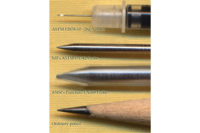Real-world uses of gloves

Selection of hand protection for cold environments
OSHA says: You were concerned that there are no objective standards for cold weather gear, from any of the consensus standard organizations, on which to base your PPE hazard assessment. The PPE standard for hand protection, 29 CFR 1910.138, specifies the selection criteria to be used when providing hand protection.
However, unlike the other revised PPE standards for eye and face, head and foot protection, the hand protection regulation does not specify criteria for the actual equipment to be provided to employees. The standard states, “Employers shall base the selection of the appropriate hand protection on an evaluation of the performance characteristics of the hand protection relative to the tasks to be performed, conditions present, duration of use, and the hazards and potential hazards identified.”
As stated in paragraph 2 of Appendix B, Assessment and selection, “It should be the responsibility of the safety officer to exercise common sense and appropriate expertise to accomplish these tasks.”
Employers should use manufacturers’ data on the effectiveness of any given product to protect against cold, as well as employee feedback, in selecting hand protection.
March, 1995
Changing disposable gloves between patient contacts
OSHA says: In your letter, you requested clarification of the CDC’s requirements for the use of clean gloves during patient transport. Your paraphrased scenario is presented below, followed by our response. Please be aware that this response may not be applicable to any scenario or question not delineated within your original correspondence.
strong>Scenario: On December 6, 2006, your hospital’s operating room (OR) staff was informed by the Infection Control personnel that it was no longer acceptable for the OR employees to wear clean exam gloves while transporting patients, nor was it acceptable to wear clean exam gloves when transporting trash and linen to the decontamination area. The rationale offered for this policy was that if the patients were provided and are using clean gowns and linen, there was no need for gloves. Also, if the trash and linen bags were not soiled, then there was no need for gloves either. However, it is your belief that you and your fellow co-workers should protect yourselves by using clean gloves during all transport. Further, you were advised by your supervisor that you will be counseled on your behavior should you continue to wear clean exam gloves while performing the above mentioned duties.
Response: The personal protective equipment requirements of OSHA’s Bloodborne Pathogen standard at 29 CFR 1910.1030(d)(3), are performance-oriented. As such, it is the employer’s responsibility to evaluate the tasks and the types of exposure expected at his or her workplace and, based on the determination, select the “appropriate” personal protective equipment in accordance with paragraph 1910.1030(d)(3)(i) of the standard.
At a minimum, gloves must be used where there is reasonable anticipation of employee hand contact with blood, other potentially infectious material (OPIM), mucous membranes, or non-intact skin and when handling or touching contaminated surfaces or items. Please bear in mind that the term “contaminated” is defined as the presence or the reasonably anticipated presence of blood or other potentially infectious materials, rather than just “visibly” contaminated.
OSHA requires that disposable gloves be changed as soon as practical when contaminated and as soon as feasible when they are torn or punctured. These requirements protect the employee from exposure to the hazards of bloodborne pathogens. OSHA does not require that gloves be changed between patients if they are not contaminated and their barrier properties have not been compromised. However, as stated in the preamble to the standard, changing gloves between patient contacts is good infection control practice to eliminate patient-to-patient transmission of disease. Additionally, if the conditions you described in your letter are anticipated to occur, such as the chance of patients’ tubes and catheters splashing employees during transport, then certainly, gloves must be used, to protect the employee from exposure to blood or OPIM. Further, employees who have contact with contaminated linen and trash must wear protective gloves which must be changed when contaminated.
In addition, please be aware that, should the situation arise where you or your fellow co-workers have to change your gloves and are denied and/or your supervisor retaliates, you may wish to contact the local OSHA Area Office. OSHA, in addition to investigating safety and health complaints, has authority under Section 11(c) of the Occupational Safety and Health Act to investigate and take appropriate action on an employee reprisal, if it resulted from filing a safety or health complaint with OSHA or a complaint to an employer.
April, 2007
Gloves used to meet PPE requirements of bloodborne pathogens standard
OSHA says: This is in response to your letter in which you requested clarification concerning the use of gloves in administering routine injections under the Occupational Safety and Health Administration (OSHA) regulation, 29 CFR 1910.1030, “Occupational Exposure to Bloodborne Pathogens.”
The personal protective equipment requirements of the standard are performance oriented. That is, it is the employer’s responsibility to evaluate the task and the type of exposure expected and, based on the determination, select the “appropriate” personal protective equipment in accordance with paragraph (d)(3)(i) of the standard.
At a minimum, gloves must be used where there is reasonable anticipation of employee hand contact with blood, other potentially infectious material, mucous membranes, or non-intact skin; when performing vascular access procedures; or when handling or touching contaminated surfaces or items.
In general, OSHA agrees with you that gloves are not necessary when giving routine injections as long as hand contact with blood or other potentially infectious material is not anticipated. If bleeding is anticipated and the employee is required to clean the site following injection, then gloves must be worn. Additionally, if the patient’s skin is abraded, gloves would be required.
September, 1992
Cradle-to-cradle use of insulating rubber gloves and sleeves
OSHA says: Protocols related to effective use of insulating rubber gloves and sleeves:
- When employees are working on energized circuits or equipment using the rubber glove method, rubber protective-insulating gloves and sleeves rated for the exposure of the highest nominal voltage shall be worn cradle-to-cradle when working from an aerial platform.
- a. Rubber protective insulating sleeves are not required when employees are working circuits with a potential of 600 volts or less if there is no upper arm exposure and the worker will not encroach the 5-foot primary zone.
- b. The term “effective cover up” is used to describe the installation of phase-to-phase rated insulating protective cover on energized conductors and/or equipment of different potentials when the lineman is within reaching distance or in areas extended by handling conductive objects.
- c. The term “extended reach” is used to describe being within five feet of energized conductors and/or equipment or having a conductive object within five feet of energized conductors and/or equipment.
- Electrical class rating of the insulating rubber sleeves shall meet or exceed the electrical class rating of the insulating rubber gloves when working on primary conductors.
- Company policies shall apply when the above conditions cannot be met. Alternative work methods ensuring worker safety shall be identified, communicated to all affected workers, implemented and documented as part of the Job Briefing process.
- Provides specific use requirements that are proven methods for reducing electrical contact injuries and fatalities.
- Provides for uniform use guidelines that can be applied industry wide.
OSHA says: You have questions regarding OSHA’s Electric power generation, transmission, and distribution standard, 29 CFR §1910.269 and the requirements for personal protective equipment when working with and around underground lines and pad-mount transformers. Your paraphrased inquiry and our response follow.
Question: What personal protective equipment (PPE) is required to be in compliance with the requirements for working within the minimum approach distances (MADs) of underground pad-mount transformers? Are both insulating gloves and insulating sleeves required?
Response: The requirements for working within the MADs of underground lines and transformers are the same as when working within the MADs of overhead lines. Paragraph 1910.269(l) addresses working on or near exposed energized parts; it is not limited to overhead lines. This paragraph does not differentiate based on nature of the component (line versus equipment), nor does it differentiate on the basis of the location of the energized part (overhead versus underground). Therefore, the requirements found in 1910.269(l) apply regardless of the location or nature of the exposed energized part(s), including those that require electrical protective equipment.
Regarding your question on the use of gloves and sleeves, 1910.269(l)(2)(i) allows for employees to work within the MADs of energized parts if they are wearing insulating gloves and insulating sleeves in accordance with 1910.269(l)(3). Paragraph 1910.269(l)(3) requires that, if employees are insulated from the energized parts through the use of insulating gloves, then insulating sleeves are also required with two exceptions. There are two conditions noted in 1910.269(l)(3)(i) and 1910.269(l)(3)(ii) that would allow an employee to use insulating gloves without the use of insulating sleeves: 1) if exposed energized parts on which work is not being performed are insulated from the employee; and 2) if such insulation is placed from a position not exposing the employee’s upper arm to contact with other energized parts.
September, 2006
Looking for a reprint of this article?
From high-res PDFs to custom plaques, order your copy today!




